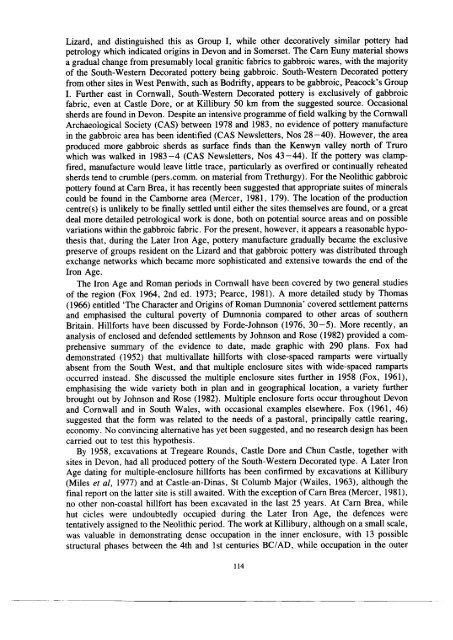Cornwall during the Iron Age and - Cornwall Archaeological Society
Cornwall during the Iron Age and - Cornwall Archaeological Society
Cornwall during the Iron Age and - Cornwall Archaeological Society
Create successful ePaper yourself
Turn your PDF publications into a flip-book with our unique Google optimized e-Paper software.
Lizard, <strong>and</strong> distinguished this as Group I, while o<strong>the</strong>r decoratively similar pottery had<br />
petrology which indicated origins in Devon <strong>and</strong> in Somerset. The Cam Euny material shows<br />
a gradual change from presumably local granitic fabrics to gabbroic wares, with <strong>the</strong> majority<br />
of <strong>the</strong> South-Western Decorated pottery being gabbroic. South-Western Decorated pottery<br />
from o<strong>the</strong>r sites in West Penwith, such as Bodrifty, appears to be gabbroic, Peacock's Group<br />
I. Fur<strong>the</strong>r east in <strong>Cornwall</strong>, South-Western Decorated pottery is exclusively of gabbroic<br />
fabric, even at Castle Dore, or at Killibury 50 km from <strong>the</strong> suggested source. Occasional<br />
sherds are found in Devon. Despite an intensive programme of field walking by <strong>the</strong> <strong>Cornwall</strong><br />
<strong>Archaeological</strong> <strong>Society</strong> (CAS) between 1978 <strong>and</strong> 1983, no evidence of pottery manufacture<br />
in <strong>the</strong> gabbroic area has been identified (CAS Newsletters, Nos 28-40). However, <strong>the</strong> area<br />
produced more gabbroic sherds as surface finds than <strong>the</strong> Kenwyn valley north of Truro<br />
which was walked in 1983-4 (CAS Newsletters, Nos 43-44). If <strong>the</strong> pottery was clampfired,<br />
manufacture would leave little trace, particularly as overfired or continually reheated<br />
sherds tend to crumble (pers.comm. on material from Trethurgy). For <strong>the</strong> Neolithic gabbroic<br />
pottery found at Cam Brea, it has recently been suggested that appropriate suites of minerals<br />
could be found in <strong>the</strong> Camborne area (Mercer, 1981, 179). The location of <strong>the</strong> production<br />
centre(s) is unlikely to be finally settled until ei<strong>the</strong>r <strong>the</strong> sites <strong>the</strong>mselves are found, or a great<br />
deal more detailed petrological work is done, both on potential source areas <strong>and</strong> on possible<br />
variations within <strong>the</strong> gabbroic fabric. For <strong>the</strong> present, however, it appears a reasonable hypo<strong>the</strong>sis<br />
that, <strong>during</strong> <strong>the</strong> Later <strong>Iron</strong> <strong>Age</strong>, pottery manufacture gradually became <strong>the</strong> exclusive<br />
preserve of groups resident on <strong>the</strong> Lizard <strong>and</strong> that gabbroic pottery was distributed through<br />
exchange networks which became more sophisticated <strong>and</strong> extensive towards <strong>the</strong> end of <strong>the</strong><br />
<strong>Iron</strong> <strong>Age</strong>.<br />
The <strong>Iron</strong> <strong>Age</strong> <strong>and</strong> Roman periods in <strong>Cornwall</strong> have been covered by two general studies<br />
of <strong>the</strong> region (Fox 1964, 2nd ed. 1973; Pearce, 1981). A more detailed study by Thomas<br />
(1966) entitled 'The Character <strong>and</strong> Origins of Roman Dumnonia' covered settlement patterns<br />
<strong>and</strong> emphasised <strong>the</strong> cultural poverty of Dumnonia compared to o<strong>the</strong>r areas of sou<strong>the</strong>rn<br />
Britain. Hillforts have been discussed by Forde-Johnson (1976, 30-5). More recently, an<br />
analysis of enclosed <strong>and</strong> defended settlements by Johnson <strong>and</strong> Rose (1982) provided a comprehensive<br />
summary of <strong>the</strong> evidence to date, made graphic with 290 plans. Fox had<br />
demonstrated (1952) that multivallate hillforts with close-spaced ramparts were virtually<br />
absent from <strong>the</strong> South West, <strong>and</strong> that multiple enclosure sites with wide-spaced ramparts<br />
occurred instead. She discussed <strong>the</strong> multiple enclosure sites fur<strong>the</strong>r in 1958 (Fox, 1961),<br />
emphasising <strong>the</strong> wide variety both in plan <strong>and</strong> in geographical location, a variety fur<strong>the</strong>r<br />
brought out by Johnson <strong>and</strong> Rose (1982). Multiple enclosure forts occur throughout Devon<br />
<strong>and</strong> <strong>Cornwall</strong> <strong>and</strong> in South Wales, with occasional examples elsewhere. Fox (1961, 46)<br />
suggested that <strong>the</strong> form was related to <strong>the</strong> needs of a pastoral, principally cattle rearing,<br />
economy. No convincing alternative has yet been suggested, <strong>and</strong> no research design has been<br />
carried out to test this hypo<strong>the</strong>sis.<br />
By 1958, excavations at Tregeare Rounds, Castle Dore <strong>and</strong> Chun Castle, toge<strong>the</strong>r with<br />
sites in Devon, had all produced pottery of <strong>the</strong> South-Western Decorated type. A Later <strong>Iron</strong><br />
<strong>Age</strong> dating for multiple-enclosure hillforts has been confirmed by excavations at Killibury<br />
(Miles et al, 1977) <strong>and</strong> at Castle-an-Dinas, St Columb Major (Wailes, 1963), although <strong>the</strong><br />
final report on <strong>the</strong> latter site is still awaited. With <strong>the</strong> exception of Cam Brea (Mercer, 1981),<br />
no o<strong>the</strong>r non-coastal hillfort has been excavated in <strong>the</strong> last 25 years. At Cam Brea, while<br />
hut cicles were undoubtedly occupied <strong>during</strong> <strong>the</strong> Later <strong>Iron</strong> <strong>Age</strong>, <strong>the</strong> defences were<br />
tentatively assigned to <strong>the</strong> Neolithic period. The work at Killibury, although on a small scale,<br />
was valuable in demonstrating dense occupation in <strong>the</strong> inner enclosure, with 13 possible<br />
structural phases between <strong>the</strong> 4th <strong>and</strong> 1st centuries BC/AD, while occupation in <strong>the</strong> outer<br />
114




